’Manus x Machina': The Met puts couture's métiers in an OMA-designed spotlight
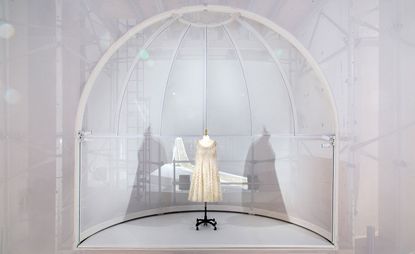
Machine-made fashion has always threatened to overwhelm the more refined, yet fading traditions of hand craftsmanship, but the Costume Institute’s latest staging of ‘Manus x Machina: Fashion in an Age of Technology’ will happily debunk that diatribe. Comprised of over 170 pieces of haute couture garments and envelope-pushing ready-to-wear pieces, the exhibition traces the development of haute couture and discusses how industrial production has impacted (and in some cases, even continued) the highly worked, intricately detailed face of fashion.
Staged in the Robert Lehman Wing galleries on the museum’s ground and first floors, the exhibition has been installed within a dramatic cathedral-like structure designed by OMA. Constructed from translucent white scrims that have been stretched over an intentionally visible framework, the building-within-a-building feel unfolds as a series of alcoves and porte-cochères that radiate out from a central domed atrium.
OMA’s lead designer Shohei Shigematsu says, ‘We really wanted to create a shell that integrated the media, garments and texts together. Each of these different porte-cochères showcase the garments, along with projections of their details that work to amplify the craftsmanship in the pieces.’
Visually, the installation has an intentionally unfinished quality, visible from the skeleton framework of structural steel, wooden boards and exposed spotlights that peek out from behind and between the scrims, that have been stretched over and tucked into the system. Juxtaposed by the unadulterated finery exhibited in each space, the concept and design brings a modern, seductive quality to the exhibition that completely upends Wong Kar-wai’s sumptuous dreamscape from the year before.
Sartorially, ‘Manus x Machina’ justly spotlights each of haute couture’s fading métiers – from featherwork and embroidered flowers, to leatherwork, pleating, lacework and construction. Each category is armed with specimens of both tradition and the new. By pitting Iris van Herpen’s synthetic knit dresses, festooned with acrylic ‘feathers’ and fringe, with a 1956 Cristóbal Balenciaga gown hand-finished with glued pink ostrich feathers, the case is certainly made that technology has far from diminished the credibility of couture’s fine art.
‘Manus x Machina' challenges the conventions of the hand/machine dichotomy and proposes a new paradigm germane to our age of technology,’ says Andrew Bolton, the Costume Institute’s curator. ‘Traditionally, the distinction between the haute couture and prêt-à-porter was based on the handmade and the machine-made, but this distinction has become increasingly blurred as both disciplines have embraced the practices and techniques of the other.’
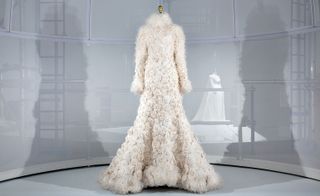
The exhibition design has been conceived by OMA, who installed a dramatic cathedral-like structure constructed from translucent white scrims that have been stretched over an intentionally visible framework. Pictured: a wedding ensemble from Chanel's A/W 2005 haute couture collection
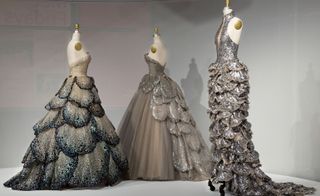
‘Manus x Machina’ justly spotlights each of haute couture’s fading métiers – from featherwork and embroidered flowers, to leatherwork, pleating, lacework and construction. Pictured: a pair of hand-finished Christian Dior gowns from 1949 (pictured left and centre) and a hand-embroidered Alexander McQueen gown from 2012 (right)
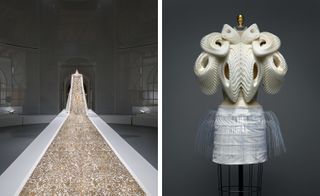
Pictured left: Chanel's wedding ensemble from A/W 2014 (left) inspired the curator Andrew Bolton with its 'haute couture without the couture' philosophy. Right: Iris van Herpen's 3D printed white polymide dress features machine-sewn white goat leather and hand-cut acrylic fringe
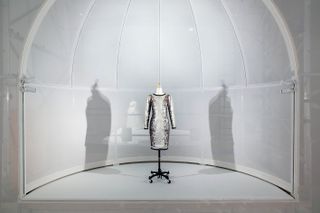
OMA’s lead designer Shohei Shigematsu says, ‘We really wanted to create a shell that integrated the media, garments and texts together. Each of these different porte-cochères showcase the garments, along with projections of their details that work to amplify the craftsmanship in the pieces'
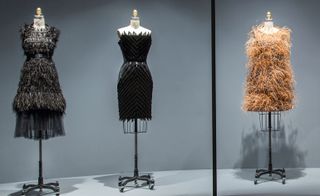
Three gowns from the exhibition's featherwork gallery. Pictured from left: a hand-sewn black silk tulle dress, hand-embroidered with black crystals by Lemarié from Chanel's A/W 2015 haute couture collection; a machine-sewn black silk-wool gazar dress, hand-embroidered with black plastic drinking straws from Gareth Pugh's A/W 2015 prêt-à-porter collection; and an evening dress featuring hand-glued brown and white ostrich feathers by Hubert de Givenchy from 1966–67
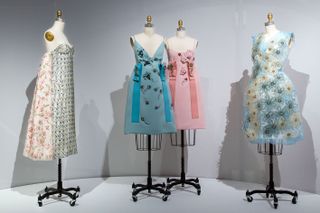
A view of the artificial flowers gallery, featuring gowns by (from left to right) Dior, Prada and Louis Vuitton
INFORMATION
’Manus x Machina: Fashion in an Age of Technology’ is on view from 5 May – 14 August. For more information, visit The Met’s website
Photography courtesy of The Met
ADDRESS
The Metropolitan Museum of Art
1000 Fifth Ave
New York, NY 10028
Wallpaper* Newsletter
Receive our daily digest of inspiration, escapism and design stories from around the world direct to your inbox.
Pei-Ru Keh is a former US Editor at Wallpaper*. Born and raised in Singapore, she has been a New Yorker since 2013. Pei-Ru held various titles at Wallpaper* between 2007 and 2023. She reports on design, tech, art, architecture, fashion, beauty and lifestyle happenings in the United States, both in print and digitally. Pei-Ru took a key role in championing diversity and representation within Wallpaper's content pillars, actively seeking out stories that reflect a wide range of perspectives. She lives in Brooklyn with her husband and two children, and is currently learning how to drive.
-
 This listed house in London is transformed through a contemporary celebration of the arch
This listed house in London is transformed through a contemporary celebration of the archSegmental House, a listed house transformation by Dominic McKenzie Architects, taps into the playful powers of the contemporary arch
By Ellie Stathaki Published
-
 The Rolls-Royce Ghost Series II glides into the DMs of the world’s 1 per cent
The Rolls-Royce Ghost Series II glides into the DMs of the world’s 1 per centThe Series II version of the ‘Baby Rolls’ has slight but sophisticated revisions to keep this hefty saloon in the targets of an increasingly idiosyncratic and individualist buyer
By Jonathan Bell Published
-
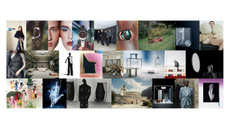 The 24 best photographs of 2024, shot for the pages of Wallpaper*
The 24 best photographs of 2024, shot for the pages of Wallpaper*Photography editor, Sophie Gladstone, completes her year in review, with some personal highlights from Wallpaper* photographers in 2024
By Sophie Gladstone Published
-
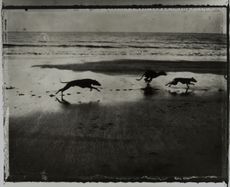 Sarah Moon brings painterly fashion and dark fantasy to Fotografiska New York
Sarah Moon brings painterly fashion and dark fantasy to Fotografiska New YorkOctogenarian French photographer and filmmaker Sarah Moon shows 30 years of work at Fotografiska New York – spanning fashion and fantasy, mystery and the macabre, it’s dark, painterly and compelling
By Pei-Ru Keh Last updated
-
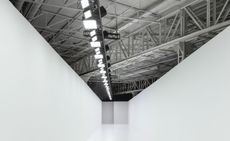 Sunnei goes to outer space for S/S 2022
Sunnei goes to outer space for S/S 2022Milanese label Sunnei staged a disruptive show experience for its S/S 2022 show, in collaboration with experimental interdisciplinary agency 2050+
By Laura Hawkins Last updated
-
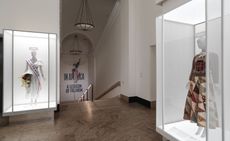 ‘In America: A Lexicon of American Fashion' is coming to The Met
‘In America: A Lexicon of American Fashion' is coming to The MetThe first of a two-part, year-long extravaganza, ‘In America: A Lexicon of American Fashion’ is organised into 12 sections that seek to define the emotional qualities in American style
By Pei-Ru Keh Last updated
-
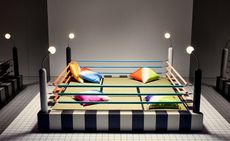 Saint Laurent celebrates 40 years of Memphis Group
Saint Laurent celebrates 40 years of Memphis GroupMemphis Group's milestone birthday is celebrated with a series of colourful furniture installations across the French maison's concept boutiques
By Laura Hawkins Last updated
-
 ‘A place for the eye to pause’: Ulla Johnson unveils New York HQ
‘A place for the eye to pause’: Ulla Johnson unveils New York HQThe Manhattan-born fashion designer opens a warmly-hued style sanctuary, created in collaboration with architect Rafael de Cárdenas
By Tilly Macalister-Smith Last updated
-
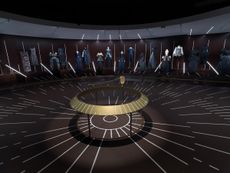 Es Devlin-designed time-travelling exhibition opens at The Met’s Costume Institute
Es Devlin-designed time-travelling exhibition opens at The Met’s Costume Institute‘Our aim is to communicate the phenomenon of time as it is expressed through the female form,’ says Devlin of the exhibition she has designed alongside curator Andrew Bolton
By Pei-Ru Keh Last updated
-
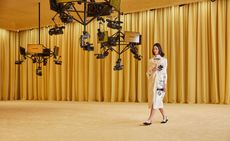 Miuccia Prada and Raf Simons rove the digital realm for S/S 2021
Miuccia Prada and Raf Simons rove the digital realm for S/S 2021‘Technology is a part of humanity itself’ said the duo of their live streamed S/S 2021 show
By Laura Hawkins Last updated
-
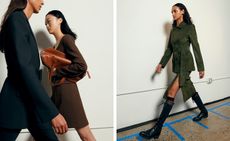 Theory A/W 2020 New York Fashion Week Women’s
Theory A/W 2020 New York Fashion Week Women’sBy Tilly Macalister-Smith Last updated